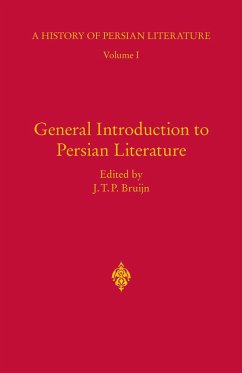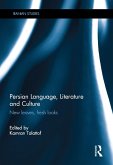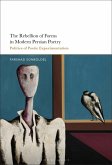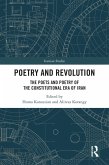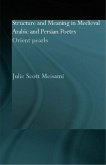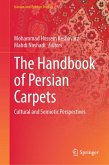General Introduction to Persian Literature (eBook, PDF)
History of Persian Literature A, Vol I
Redaktion: Bruijn, J. T. P.
108,95 €
108,95 €
inkl. MwSt.
Sofort per Download lieferbar

54 °P sammeln
108,95 €
Als Download kaufen

108,95 €
inkl. MwSt.
Sofort per Download lieferbar

54 °P sammeln
Jetzt verschenken
Alle Infos zum eBook verschenken
108,95 €
inkl. MwSt.
Sofort per Download lieferbar
Alle Infos zum eBook verschenken

54 °P sammeln
General Introduction to Persian Literature (eBook, PDF)
History of Persian Literature A, Vol I
Redaktion: Bruijn, J. T. P.
- Format: PDF
- Merkliste
- Auf die Merkliste
- Bewerten Bewerten
- Teilen
- Produkt teilen
- Produkterinnerung
- Produkterinnerung

Bitte loggen Sie sich zunächst in Ihr Kundenkonto ein oder registrieren Sie sich bei
bücher.de, um das eBook-Abo tolino select nutzen zu können.
Hier können Sie sich einloggen
Hier können Sie sich einloggen
Sie sind bereits eingeloggt. Klicken Sie auf 2. tolino select Abo, um fortzufahren.

Bitte loggen Sie sich zunächst in Ihr Kundenkonto ein oder registrieren Sie sich bei bücher.de, um das eBook-Abo tolino select nutzen zu können.
Persian literature is the jewel in the crown of Persian culture. It has profoundly influenced the literatures of Ottoman Turkey, Muslim India and Turkic Central Asia and been a source of inspiration for Goethe, Emerson, Matthew Arnold and Jorge Luis Borges among others. Yet Persian literature has never received the attention it truly deserves."A History of Persian Literature" answers this need and offers a new, comprehensive and detailed history of its subject. This 18-volume, authoritative survey reflects the stature and significance of Persian literature as the single most important…mehr
- Geräte: PC
- mit Kopierschutz
- eBook Hilfe
- Größe: 5.75MB
Andere Kunden interessierten sich auch für
![Persian Language, Literature and Culture (eBook, PDF) Persian Language, Literature and Culture (eBook, PDF)]() Persian Language, Literature and Culture (eBook, PDF)43,95 €
Persian Language, Literature and Culture (eBook, PDF)43,95 €![Sadeq Hedayat (eBook, PDF) Sadeq Hedayat (eBook, PDF)]() Sadeq Hedayat (eBook, PDF)45,95 €
Sadeq Hedayat (eBook, PDF)45,95 €![The Rebellion of Forms in Modern Persian Poetry (eBook, PDF) The Rebellion of Forms in Modern Persian Poetry (eBook, PDF)]() Farshad SonboldelThe Rebellion of Forms in Modern Persian Poetry (eBook, PDF)24,95 €
Farshad SonboldelThe Rebellion of Forms in Modern Persian Poetry (eBook, PDF)24,95 €![Poetry and Revolution (eBook, PDF) Poetry and Revolution (eBook, PDF)]() Poetry and Revolution (eBook, PDF)41,95 €
Poetry and Revolution (eBook, PDF)41,95 €![Structure and Meaning in Medieval Arabic and Persian Lyric Poetry (eBook, PDF) Structure and Meaning in Medieval Arabic and Persian Lyric Poetry (eBook, PDF)]() Julie MeisamiStructure and Meaning in Medieval Arabic and Persian Lyric Poetry (eBook, PDF)45,95 €
Julie MeisamiStructure and Meaning in Medieval Arabic and Persian Lyric Poetry (eBook, PDF)45,95 €![General Prologue to the Canterbury Tales (eBook, PDF) General Prologue to the Canterbury Tales (eBook, PDF)]() Geoffrey ChaucerGeneral Prologue to the Canterbury Tales (eBook, PDF)24,95 €
Geoffrey ChaucerGeneral Prologue to the Canterbury Tales (eBook, PDF)24,95 €![The Handbook of Persian Carpets (eBook, PDF) The Handbook of Persian Carpets (eBook, PDF)]() The Handbook of Persian Carpets (eBook, PDF)167,95 €
The Handbook of Persian Carpets (eBook, PDF)167,95 €-
-
-
Persian literature is the jewel in the crown of Persian culture. It has profoundly influenced the literatures of Ottoman Turkey, Muslim India and Turkic Central Asia and been a source of inspiration for Goethe, Emerson, Matthew Arnold and Jorge Luis Borges among others. Yet Persian literature has never received the attention it truly deserves."A History of Persian Literature" answers this need and offers a new, comprehensive and detailed history of its subject. This 18-volume, authoritative survey reflects the stature and significance of Persian literature as the single most important accomplishment of the Iranian experience. It includes extensive, revealing examples with contributions by prominent scholars who bring a fresh critical approach to bear on this important topic.The first volume offers an indispensable entree to Persian literature's long and rich history, examining themes and subjects that are common to many fields of Persian literary study. This invaluable introduction to the subject heralds a definitive and ground-breaking new series.
Produktdetails
- Produktdetails
- Verlag: Bloomsbury eBooks UK
- Seitenzahl: 600
- Erscheinungstermin: 31. Oktober 2008
- Englisch
- ISBN-13: 9780857723574
- Artikelnr.: 58646857
- Verlag: Bloomsbury eBooks UK
- Seitenzahl: 600
- Erscheinungstermin: 31. Oktober 2008
- Englisch
- ISBN-13: 9780857723574
- Artikelnr.: 58646857
- Herstellerkennzeichnung Die Herstellerinformationen sind derzeit nicht verfügbar.
Johannes Thomas Pieter de Bruijn is Professor Emeritus of Persian at the University of Leiden. Ehsan Yarshater is the Director of the Center for Iranian Studies and Professor Emeritus of Iranian Studies, Columbia University and the Founding Editor of the Encyclopaedia Iranica.
Foreword
Chapter 1: Classical Persia n Literature as a Tradition (J. T. P. de
Bruijn)
1. Preliminary Remarks
2. Documentation
3. The Birth of a Tradition
4. Writers, Poets, Minstrels and Patrons
Writers
Poets
Minstrels
Patronage
Alternatives to Court Poetry
5. Religious Inspiration
6. The Transmission of Literature
7. The Individuality of the Writer and the Poet
8. Views on Poetry
CHAPTER 2: THE OR IGIN AND DEVELOPMENT OF LITER ARY PERS IAN (J. Perry)
1. The Fall of Middle Persian and the Rise of Persian
2. The Language Arena, ca. 570-900
3. Pârsi and Dari
4. Arabic and Persian: A Fortunate Conjunction
5. Building a Literary Language
6. Expansion and Standardization
7. Classical Persian
Chap er 3: the history of literature (W. Hanaway)
Chap ter 4: Prosody : mete r and rhyme (B. Utas)
1. Meter in Persian Poetry
2. Rhyme in Persian Poetry
3. The Pre-Islamic Prosodic Heritage
4. Khalil's Analysis of Arabic Metrics
5. The Persian Version of the aruz System
6. Scansion
7. Caesura
8. Pitch and Stress
9. Special Features of Persian Rhyme and Verse Forms
10. The robâ'i and the Prosody of Folk Poetry
11. The Role of Meter and Rhyme in PersianPoetical Genres
Chapter 5: Traditional Literary Theory: The Arabic Backg round (G. J. Van
Gelder) . . . .
1. Arabic Theory and Persian Literature
2. Origins and Early Developments
3. The Scholastic Study of balâgha
4. From Arabic Legacy to Persian Theory
5. The Deficiencies of Arabic Theory
Chapter 6: Persian Rhetoric: Elme badi 'and elme bayân (N. Chalisova)
1. The Persian Theory of Rhetoric Embellishment
2. Râduyâni's Tarjomân al-balâgha
3. Vatvât's Hadâ'eq al-sehr
4. Shamse Qeys' Mo'jam
5. The qaside-ye masnu'
6. Commentaries of the Hadâ'eq
7. Hoseyni's Badâye' al-sanâye'
8. Postclassical Treatises
9. Concluding Remarks
Chapter 7: Poetic Imagery (R. Zipoli)
Inventory of Persian Poetic Imagery
The Natural World
Animals
Plants and Flowers
Precious Substances
The Sky, Planets, Stars, and Constellations
Other Natural Elements
Colors
The Measurement of Time
The Human World
The Body
Other Bodily Components
Actions and Emotions
The Social Context
Life at Court
War
Feasting
Games
Hunting
Fabrics and clothes
Perfumes and cosmetics
Wounds and medicine
Various objects
Writing
Numbers
Characters
Places around the Court
Countries and Peoples
The Cultural Tradition
Islam
Characters and Motifs Mentioned in the Qor'an
Other Characters from the Qor'an
Other Characters and Motifs from Islamic Culture
Ritual Elements
Ancient Persian Traditions
Flouting Islamic Values
Chapter 8: Genres of Court Literature J. Meisami)
Introduction
2. Panegyric and Related Types of Poetry
3. "Informal" Lyrics
4. History
5. Epic and Romance
6. Wisdom Literature; Mirrors for Princes
7. Didactic, Religious and Philosophical Poetry and Prose
8. Epistolography and Works on Style
9. Satire and Humorous Writing
10. Conclusion
Chapter 9: Genres of Religious Literature N. Pourjavady)
1. Commentaries on the Qor'an and Stories of the Prophets
2. Manuals
3. Short Works on Mystical States and Stages nd on Spiritual Conduct
4. Hagiographies
5. Sermons
6. Allegories
7. Treatises on Love
8. Didactic and Theoretical Works in Prose
9. Didactic Mathnavis
Chapter 10: Ri ddles (G. Windfuhr)
1. Pre-Islamic Period
2. The Islamic Period
3. Loghaz and mo'ammâ
4. Indigenous Tradition and Scholarship
5. Modern Scholarship
6. The Theory of the mo'ammâ
7. Hesabe abjad
8. Târikh
9. The Gnostic-Mystical Factor
Appendix
Chapter 11: Pre-Islamic Iranian and Indian Influences on Persian Literature
(F. de Blois) .
1. Kalile and Demne
2. The Book of Kings
3. The Book of Sendbâd
4. Belawhar and Budhâsaf
5. Vis and Râmin
6. The Letter of Tansar
Chapter 12: Hell enistic Influences in Classical Persia n L
Chapter 1: Classical Persia n Literature as a Tradition (J. T. P. de
Bruijn)
1. Preliminary Remarks
2. Documentation
3. The Birth of a Tradition
4. Writers, Poets, Minstrels and Patrons
Writers
Poets
Minstrels
Patronage
Alternatives to Court Poetry
5. Religious Inspiration
6. The Transmission of Literature
7. The Individuality of the Writer and the Poet
8. Views on Poetry
CHAPTER 2: THE OR IGIN AND DEVELOPMENT OF LITER ARY PERS IAN (J. Perry)
1. The Fall of Middle Persian and the Rise of Persian
2. The Language Arena, ca. 570-900
3. Pârsi and Dari
4. Arabic and Persian: A Fortunate Conjunction
5. Building a Literary Language
6. Expansion and Standardization
7. Classical Persian
Chap er 3: the history of literature (W. Hanaway)
Chap ter 4: Prosody : mete r and rhyme (B. Utas)
1. Meter in Persian Poetry
2. Rhyme in Persian Poetry
3. The Pre-Islamic Prosodic Heritage
4. Khalil's Analysis of Arabic Metrics
5. The Persian Version of the aruz System
6. Scansion
7. Caesura
8. Pitch and Stress
9. Special Features of Persian Rhyme and Verse Forms
10. The robâ'i and the Prosody of Folk Poetry
11. The Role of Meter and Rhyme in PersianPoetical Genres
Chapter 5: Traditional Literary Theory: The Arabic Backg round (G. J. Van
Gelder) . . . .
1. Arabic Theory and Persian Literature
2. Origins and Early Developments
3. The Scholastic Study of balâgha
4. From Arabic Legacy to Persian Theory
5. The Deficiencies of Arabic Theory
Chapter 6: Persian Rhetoric: Elme badi 'and elme bayân (N. Chalisova)
1. The Persian Theory of Rhetoric Embellishment
2. Râduyâni's Tarjomân al-balâgha
3. Vatvât's Hadâ'eq al-sehr
4. Shamse Qeys' Mo'jam
5. The qaside-ye masnu'
6. Commentaries of the Hadâ'eq
7. Hoseyni's Badâye' al-sanâye'
8. Postclassical Treatises
9. Concluding Remarks
Chapter 7: Poetic Imagery (R. Zipoli)
Inventory of Persian Poetic Imagery
The Natural World
Animals
Plants and Flowers
Precious Substances
The Sky, Planets, Stars, and Constellations
Other Natural Elements
Colors
The Measurement of Time
The Human World
The Body
Other Bodily Components
Actions and Emotions
The Social Context
Life at Court
War
Feasting
Games
Hunting
Fabrics and clothes
Perfumes and cosmetics
Wounds and medicine
Various objects
Writing
Numbers
Characters
Places around the Court
Countries and Peoples
The Cultural Tradition
Islam
Characters and Motifs Mentioned in the Qor'an
Other Characters from the Qor'an
Other Characters and Motifs from Islamic Culture
Ritual Elements
Ancient Persian Traditions
Flouting Islamic Values
Chapter 8: Genres of Court Literature J. Meisami)
Introduction
2. Panegyric and Related Types of Poetry
3. "Informal" Lyrics
4. History
5. Epic and Romance
6. Wisdom Literature; Mirrors for Princes
7. Didactic, Religious and Philosophical Poetry and Prose
8. Epistolography and Works on Style
9. Satire and Humorous Writing
10. Conclusion
Chapter 9: Genres of Religious Literature N. Pourjavady)
1. Commentaries on the Qor'an and Stories of the Prophets
2. Manuals
3. Short Works on Mystical States and Stages nd on Spiritual Conduct
4. Hagiographies
5. Sermons
6. Allegories
7. Treatises on Love
8. Didactic and Theoretical Works in Prose
9. Didactic Mathnavis
Chapter 10: Ri ddles (G. Windfuhr)
1. Pre-Islamic Period
2. The Islamic Period
3. Loghaz and mo'ammâ
4. Indigenous Tradition and Scholarship
5. Modern Scholarship
6. The Theory of the mo'ammâ
7. Hesabe abjad
8. Târikh
9. The Gnostic-Mystical Factor
Appendix
Chapter 11: Pre-Islamic Iranian and Indian Influences on Persian Literature
(F. de Blois) .
1. Kalile and Demne
2. The Book of Kings
3. The Book of Sendbâd
4. Belawhar and Budhâsaf
5. Vis and Râmin
6. The Letter of Tansar
Chapter 12: Hell enistic Influences in Classical Persia n L
Foreword
Chapter 1: Classical Persia n Literature as a Tradition (J. T. P. de
Bruijn)
1. Preliminary Remarks
2. Documentation
3. The Birth of a Tradition
4. Writers, Poets, Minstrels and Patrons
Writers
Poets
Minstrels
Patronage
Alternatives to Court Poetry
5. Religious Inspiration
6. The Transmission of Literature
7. The Individuality of the Writer and the Poet
8. Views on Poetry
CHAPTER 2: THE OR IGIN AND DEVELOPMENT OF LITER ARY PERS IAN (J. Perry)
1. The Fall of Middle Persian and the Rise of Persian
2. The Language Arena, ca. 570-900
3. Pârsi and Dari
4. Arabic and Persian: A Fortunate Conjunction
5. Building a Literary Language
6. Expansion and Standardization
7. Classical Persian
Chap er 3: the history of literature (W. Hanaway)
Chap ter 4: Prosody : mete r and rhyme (B. Utas)
1. Meter in Persian Poetry
2. Rhyme in Persian Poetry
3. The Pre-Islamic Prosodic Heritage
4. Khalil's Analysis of Arabic Metrics
5. The Persian Version of the aruz System
6. Scansion
7. Caesura
8. Pitch and Stress
9. Special Features of Persian Rhyme and Verse Forms
10. The robâ'i and the Prosody of Folk Poetry
11. The Role of Meter and Rhyme in PersianPoetical Genres
Chapter 5: Traditional Literary Theory: The Arabic Backg round (G. J. Van
Gelder) . . . .
1. Arabic Theory and Persian Literature
2. Origins and Early Developments
3. The Scholastic Study of balâgha
4. From Arabic Legacy to Persian Theory
5. The Deficiencies of Arabic Theory
Chapter 6: Persian Rhetoric: Elme badi 'and elme bayân (N. Chalisova)
1. The Persian Theory of Rhetoric Embellishment
2. Râduyâni's Tarjomân al-balâgha
3. Vatvât's Hadâ'eq al-sehr
4. Shamse Qeys' Mo'jam
5. The qaside-ye masnu'
6. Commentaries of the Hadâ'eq
7. Hoseyni's Badâye' al-sanâye'
8. Postclassical Treatises
9. Concluding Remarks
Chapter 7: Poetic Imagery (R. Zipoli)
Inventory of Persian Poetic Imagery
The Natural World
Animals
Plants and Flowers
Precious Substances
The Sky, Planets, Stars, and Constellations
Other Natural Elements
Colors
The Measurement of Time
The Human World
The Body
Other Bodily Components
Actions and Emotions
The Social Context
Life at Court
War
Feasting
Games
Hunting
Fabrics and clothes
Perfumes and cosmetics
Wounds and medicine
Various objects
Writing
Numbers
Characters
Places around the Court
Countries and Peoples
The Cultural Tradition
Islam
Characters and Motifs Mentioned in the Qor'an
Other Characters from the Qor'an
Other Characters and Motifs from Islamic Culture
Ritual Elements
Ancient Persian Traditions
Flouting Islamic Values
Chapter 8: Genres of Court Literature J. Meisami)
Introduction
2. Panegyric and Related Types of Poetry
3. "Informal" Lyrics
4. History
5. Epic and Romance
6. Wisdom Literature; Mirrors for Princes
7. Didactic, Religious and Philosophical Poetry and Prose
8. Epistolography and Works on Style
9. Satire and Humorous Writing
10. Conclusion
Chapter 9: Genres of Religious Literature N. Pourjavady)
1. Commentaries on the Qor'an and Stories of the Prophets
2. Manuals
3. Short Works on Mystical States and Stages nd on Spiritual Conduct
4. Hagiographies
5. Sermons
6. Allegories
7. Treatises on Love
8. Didactic and Theoretical Works in Prose
9. Didactic Mathnavis
Chapter 10: Ri ddles (G. Windfuhr)
1. Pre-Islamic Period
2. The Islamic Period
3. Loghaz and mo'ammâ
4. Indigenous Tradition and Scholarship
5. Modern Scholarship
6. The Theory of the mo'ammâ
7. Hesabe abjad
8. Târikh
9. The Gnostic-Mystical Factor
Appendix
Chapter 11: Pre-Islamic Iranian and Indian Influences on Persian Literature
(F. de Blois) .
1. Kalile and Demne
2. The Book of Kings
3. The Book of Sendbâd
4. Belawhar and Budhâsaf
5. Vis and Râmin
6. The Letter of Tansar
Chapter 12: Hell enistic Influences in Classical Persia n L
Chapter 1: Classical Persia n Literature as a Tradition (J. T. P. de
Bruijn)
1. Preliminary Remarks
2. Documentation
3. The Birth of a Tradition
4. Writers, Poets, Minstrels and Patrons
Writers
Poets
Minstrels
Patronage
Alternatives to Court Poetry
5. Religious Inspiration
6. The Transmission of Literature
7. The Individuality of the Writer and the Poet
8. Views on Poetry
CHAPTER 2: THE OR IGIN AND DEVELOPMENT OF LITER ARY PERS IAN (J. Perry)
1. The Fall of Middle Persian and the Rise of Persian
2. The Language Arena, ca. 570-900
3. Pârsi and Dari
4. Arabic and Persian: A Fortunate Conjunction
5. Building a Literary Language
6. Expansion and Standardization
7. Classical Persian
Chap er 3: the history of literature (W. Hanaway)
Chap ter 4: Prosody : mete r and rhyme (B. Utas)
1. Meter in Persian Poetry
2. Rhyme in Persian Poetry
3. The Pre-Islamic Prosodic Heritage
4. Khalil's Analysis of Arabic Metrics
5. The Persian Version of the aruz System
6. Scansion
7. Caesura
8. Pitch and Stress
9. Special Features of Persian Rhyme and Verse Forms
10. The robâ'i and the Prosody of Folk Poetry
11. The Role of Meter and Rhyme in PersianPoetical Genres
Chapter 5: Traditional Literary Theory: The Arabic Backg round (G. J. Van
Gelder) . . . .
1. Arabic Theory and Persian Literature
2. Origins and Early Developments
3. The Scholastic Study of balâgha
4. From Arabic Legacy to Persian Theory
5. The Deficiencies of Arabic Theory
Chapter 6: Persian Rhetoric: Elme badi 'and elme bayân (N. Chalisova)
1. The Persian Theory of Rhetoric Embellishment
2. Râduyâni's Tarjomân al-balâgha
3. Vatvât's Hadâ'eq al-sehr
4. Shamse Qeys' Mo'jam
5. The qaside-ye masnu'
6. Commentaries of the Hadâ'eq
7. Hoseyni's Badâye' al-sanâye'
8. Postclassical Treatises
9. Concluding Remarks
Chapter 7: Poetic Imagery (R. Zipoli)
Inventory of Persian Poetic Imagery
The Natural World
Animals
Plants and Flowers
Precious Substances
The Sky, Planets, Stars, and Constellations
Other Natural Elements
Colors
The Measurement of Time
The Human World
The Body
Other Bodily Components
Actions and Emotions
The Social Context
Life at Court
War
Feasting
Games
Hunting
Fabrics and clothes
Perfumes and cosmetics
Wounds and medicine
Various objects
Writing
Numbers
Characters
Places around the Court
Countries and Peoples
The Cultural Tradition
Islam
Characters and Motifs Mentioned in the Qor'an
Other Characters from the Qor'an
Other Characters and Motifs from Islamic Culture
Ritual Elements
Ancient Persian Traditions
Flouting Islamic Values
Chapter 8: Genres of Court Literature J. Meisami)
Introduction
2. Panegyric and Related Types of Poetry
3. "Informal" Lyrics
4. History
5. Epic and Romance
6. Wisdom Literature; Mirrors for Princes
7. Didactic, Religious and Philosophical Poetry and Prose
8. Epistolography and Works on Style
9. Satire and Humorous Writing
10. Conclusion
Chapter 9: Genres of Religious Literature N. Pourjavady)
1. Commentaries on the Qor'an and Stories of the Prophets
2. Manuals
3. Short Works on Mystical States and Stages nd on Spiritual Conduct
4. Hagiographies
5. Sermons
6. Allegories
7. Treatises on Love
8. Didactic and Theoretical Works in Prose
9. Didactic Mathnavis
Chapter 10: Ri ddles (G. Windfuhr)
1. Pre-Islamic Period
2. The Islamic Period
3. Loghaz and mo'ammâ
4. Indigenous Tradition and Scholarship
5. Modern Scholarship
6. The Theory of the mo'ammâ
7. Hesabe abjad
8. Târikh
9. The Gnostic-Mystical Factor
Appendix
Chapter 11: Pre-Islamic Iranian and Indian Influences on Persian Literature
(F. de Blois) .
1. Kalile and Demne
2. The Book of Kings
3. The Book of Sendbâd
4. Belawhar and Budhâsaf
5. Vis and Râmin
6. The Letter of Tansar
Chapter 12: Hell enistic Influences in Classical Persia n L
